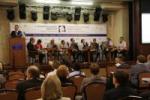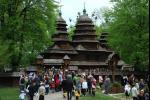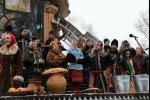- عربي
- Ukraine
- Economy
-
Investment
- Current Investment Trends
- Legal Conditions of Doing Business
- Investment Policy
- Competition
- Setting a Business in Ukraine
- Mergers and Acquisitions
- Taxation
- Import and Export
- Banks and Bank Regulation
- Convertibility and Profits Repatriation
- Currency Regulation
- Protection of Intellectual Property Rights
- Companies
- Travel to Ukraine
- About us
- Useful Sites
- Gallery
- News
Currency rates in UAH
| AED | ||
| BHD | ||
| EGP | ||
| KWD | ||
| LBP | ||
| OMR | ||
| QAR | ||
| SAR | ||
| SYP |
2015-07-06
| Kiev |  |
+32 |
| Donetsk |  |
+28 |
| Dnipropetrovsk |  |
+31 |
| Lviv |  |
+31 |
| Odessa |  |
+27 |
The Ukrainian National Revolution
On February 23, 1917, the revolution broke out in Petrohrad (the empire capital
Representative authorities in provinces came to civil organizations where representatives of trade-industrial circles and administrative bureaucracy occupied leading positions. As to their party belonging, almost all of them were constitutional democrats (cadets). A Council of United Public Organizations appeared on March
The society of Ukrainian Progressionists (organized by M. Hrushevskyi, S. Yefremov, and
The Organization of the Workers' Council began in Ukrainian industrial centers and that of soldiers' councils in harnisons and in the front immediately after overthrowing the monarchy. The workers' councils were established in Kharkiv, Kyiv, Katerynoslav and Kremenchuk. The councils were non-party organizations which had no historical analogues. Their first appearance was during the revolution of 1905-1907, and again in 1917 that gave evidence of the workers' distrust of any state institution. The call for expropriation of the tools of production was most popular in these councils. By the middle of 1917, 252 councils had been created in 9 Ukrainian provinces - including
Socialist parties of the socialist-revolutionaries (SRs) and social democrats (the Menshevists' part), who influenced the workers' and soldiers' councils during the first months of the revolution wanted to create the democratic parliamentary republic. They had no intention of proclaiming the councils under their control or for the state organs to take the political power. This is why they supported the legitimate Provisional Government. The Bolsheviks' division of social democrats (after their chief V. Lenin came back from emigration in April 1917) added this motto to their armory: "All power to the Soviets". So, the Bolsheviks stood in the way of democratic orientation of the revolutionary process. The acquisition of control over the councils (Soviets) and the announcement of the
The number of Bolsheviks in Ukrainian provinces grew quickly from 2 thousand before the revolution, to 10 thousand by the end in April 1917. Even as the minority in the councils they began organizing the army for the civil war they foresaw. They organized workers' squadrons, militia, and red-guard detachments. The resistance of councils under the control of Mensheviks and SRs and the counteractions of the local authorities of Provisional Government hindered this work to a certain extent. However, the Red Guards' detachments were created in Kyiv, Kharkiv, Katerynoslav, and Odesa.
During this time the national revolution developed. In the first announcements of the Tsentralna Rada, the national program was mainly a cultural trend. M. Hrushevskyi, who had returned from exile, put the slogan of constitution of national territorial autonomy of
The intense creation of political parties took place in
The First Universal of Tsentralna Rada was announced on June 10,
The Provisional Government had to recognize the Tsentralna Rada as a state organ. After such a success, the Rada approved the Universal II, where it informed about the creation of the General Secretariat and the development of the law on Ukrainian autonomy.
The intensification of social economic crisis continued deteriorating the material conditions of proletarized masses. Under these conditions, the extremists’ slogans of Lenin’s branch of the All-Russian Party of Social Democrats proved more and more popular. The number of Bolsheviks in
Threatened by the left extremism, the party of cadets began inclining to the settlement of national crisis before using force. With the consent of its leaders, the ruling clique of the army generals, headed by General L. Kornilov, a Supreme Commander in Chief, made an effort to overthrow the Provisional Government but he failed because the plot was not discovered.
The Bolsheviks played the main part in its discovery. Their influence essentially increased throughout the southern and eastern provinces of
On October 25, 1917, Bolsheviks overthrew the Provisional Government and at the Second All-Russian Congress of Soviets in Petrohrad, they created their own Government, in which they called the Soviet of People’s Commissars (Sovnarcom) and it was headed by V. Lenin. The October over throw created a new political situation to which the Tsentralna Rada had to react immediately. It issued its Universal III where it proclaimed the creation of the Ukrainian Republic (UPR).
Impressed by the offensive of the Russian troops controlled by Sovnarcom, the Tsentralna Rada leaders quickly lost illusions of Russia’s transformation into a democratic federal republic. The formal separation from Bolsheviks’ dictature became a main task. On the night of January 12,
On January 27, 1918, the first peace treaty of the world war was signed between the UPR and four states of the German block in Brest-Litovsk. A day before the signing of the agreement, the Soviet Army entered Kyiv and the Tsentralna Rada had to recognize that it needed immediate military help. On February 18, German and Austro-Hungarian troops began to occupy
The presence of the occupational army removed the revolutionary situation in
P. Skoropadskyi invited to his government authoritative figures who strove to work constructively. However, occupants permitted his activities only in the national-cultural sphere. Interested in removing maximum amounts of food and raw materials from
The Hetman’s regime could survive only under the occupation. On November 12,
The appearance of the Directory was unexpected for the neighbors of
The defeat in the World War lead to the disintegration of the Austro-Hungarian empire and the creation of independent states by its people. On October 18, 1918, the Ukrainian National Rada was constituted in Lviv. It proclaimed the intention to create a state on the ethno-Ukrainian lands within the empire. The reviving
In January of 1919, the government of Soviet Ukraine refused the denomination introduced by the Tsentralna Rada (UPR) and established another one that was called the Ukrainian Socialist People’s Republic (Ukrainian SSR). The government’s name also changed to Sovnarcom, as in
The elections of the workers’ council, the Red Army soldiers and peasants deputies were held in spring 1919. As a result of the manipulations with representation norms, the Bolsheviks gained a complete advantage. The Soviets only served as a cover for the dictatorship of the RCP(b)-CP(b)U which was supported by the army and Extraordinary Commission. In accordance with the Ukrainian SSR constitution, which had the constitution of Soviet Russia as a model, the All-Ukrainian Congress of Soviets became the higher legislative body and All-Ukrainian Central executive committee (AUCEC) performed its functions between congresses.
It was noted in the government declaration that the Ukrainian SSR was united with the RRFSR on principles of “Socialist Federation”. The essence of federations was not deciphered, but the RCP(b) program (adopted in March 1919) indicated that the Federate Union of Soviet states is a form of transition to complete unity. The Bolshevik party wished to centralize the military and economic management in short terms. On June 1, 1919, the all-Russian Central Executive Committee (ARCEC), proclaimed the decree about the “military-political union”. Administration of the most important branches of the state of soviet republics was concentrated in the
As soon as
The powerful tide of the peasants resistance rose in response to the policy which Lenin later called “military communism” (when it failed and they refused from it). Ataman Zelenyi (D. Terpylo), member of the party of social democrats (independent) was the first to oppose the government in the middle of March. He did his best to spread the actions of his nearly twelve thousand member army to the left bank of the Dnipro, to Pereiaslav and Zolotonosha. The detachments of Nestor Makhno (who was named a “father”, or bat’ko, by elected village atamans) operated in the Katerynoslav province that is in the region of Huliaipole. Makhno fought well against Denikin’s army that conventionally supported the soviet power and Makhno definitely opposed the anarchism of commissars and agrarian policy of Rakovksyi. The revolt of ataman M. Hryhoriev in May 1919 was the greatest.
Anti-Bolshevist rises of peasants deeply influenced the sprits of the Red Army, because they were mainly consisted of peasants, and provoked the mass desertion and general discipline relaxation. A. Denikin, a commander of the White Guards Voluntary army, took advantage of the occasion. From May to August 1919, the White Guards occupied
Having placed the economy under the command of the state, Russian Bolsheviks could create the army that greatly surpassed the number of Denikin’s armed forces. At the beginning of February 1920, the Red Army liberated the entire
When the defeat of Denikin was inevitable, the government of Soviet Russia turned its attention to
On the eve of the inevitable war with Soviet Russia, Y. Pilsudskyi, the head of the Polish state, considered it expedient to regulate relations with his former enemy, S. Petliura. Wishing to continue the war for an independent UPR, Petliura accepted his conditions. The
Pilsudskyi did not wait for the end of relocation of Soviet troops and on April 25, 1920, began the offensive along the
The threat of losing the state rights conquered in 1918 closely united the broadest ranges of the population around the government. Immediate help with arms and ammunition was given by
After the withdrawal of Y. Pilsudskyi’s troops to the



